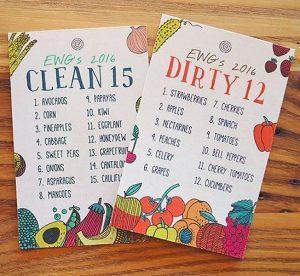According to the Environmental Working Group (EWG), the " Clean Fifteen and the Dirty Dozen " refer respectively to the fruits and vegetables that are the least and most contaminated by pesticide use within the United States. With so many Aussies referring to this list as a 'go-to' guide for pesticide exposure, I thought it was high time I do some research to see if this list is even applicable to us.

In the USA, the Department of Agriculture and the Food and Drug Administration have published in thousands of pesticide-related reports. Unfortunately, we simply don't have this pool of data in Australia to make the same conclusions. Although there is some overlap with the EWG findings, we'd be silly to make too many assumptions given what we DON'T know.
In saying this, I did find a few resources. Most of the data I looked at comes from the 23rd Australian Total Diet Study (ATDS), which was conducted in 2008. This examined the dietary exposure of the Australian population to 214 agricultural and veterinary chemicals, 9 contaminants, 12 mycotoxins and 11 nutrients (more on this here) in 92 different foods. Friends of the Earth also have a good report which is worth reading if you're keen to learn more. Importantly, they discuss the pesticide residue found in foods other than fruit and vegetables; like wheat (and bran), bread, biscuits and imported tea.
Digging Deeper into the Dirty DozenAlthough many of the foods on the American chart haven't even been tested in Australia, roughly half of the foods DO deserve to be on the chart. Australia's version of the 'Dirty Dozen' would look something like this - Apples, cabbage, strawberries, capsicum, tomatoes, celery, lettuce, mushrooms, nectarines, grapes, cucumber and oranges. All of these foods showed varying levels of pesticide residue. Some very high... apples, strawberries and lettuce I'm looking at you!
What about the Clean Fifteen?I'm in agreeance regarding sweet peas and onions. However, yet again there were quite a few foods on the EWG list which weren't even tested in Australia (such as eggplant and asparagus)! And interestingly; broccoli, lettuce, mushrooms and oranges all hadOverall, Australia's 'cleanest' were higher levels of contaminants than the USA. sweet peas, onions, bananas, carrots, frozen corn and watermelon.
Bottom Line
There are a LOT of unknowns when it comes to pesticide residue in our Australian food supply. As I've mentioned, many of the foods on the EWG chart either haven't been tested in Australia. I'm eagerly awaiting our next lot of data, and really feel there needs to be much more in the way of independent testing.
What I DO know, is that if you're wanting to buy organic, these foods should get top priority on your shopping list - Apples, cabbage, strawberries, capsicum, tomatoes, celery, lettuce, mushrooms, nectarines, grapes, cucumber and oranges. Personally, I would also err on the side of caution with foods like spinach, culinary herbs, cherries, blueberries, broccoli and asparagus.
I would also like to point out that buying organic isn't the be all and end all. It's important yes, but I feel buying local trumps buying organic (but this is for another post!). Ideally, you would obviously eat both organic AND local, but I realise that's not always possible.
Finally, to all my clients who have heard me bang on about the US version of the "Clean Fifteen and Dirty Dozen"... I'm sorry, it was naive of me! Now you have a more up to date, Aussie version 🙂
Until next time,
Stacey.
